History of the Village:
Wheeling Through The Years
The soft cover book Wheeling Through the Years
an oral history of Wheeling, an Illinois village contains
over 250 8x11 pages, and is available for purchase through the
Historical Society for $25.00 directly, or by mail with a $5.00
shipping and handling charge.
This book contains chapters on growing up in Old
Wheeling, school days, girl scouts, homesteading, Yankee farmers,
German farmers, Wheeling Train Station, Crane farms, Denoyer farm,
Milwaukee Avenue, Early planes and airports, prohibition, World War
II, Hispanics, organizations, churches, and much more. Illustrated
with photographs from the 1700's through the 1980's. Some
samples are included below.
If you are at all interested in Wheeling's past, we would like very much for you to join us in the preservation of our history and artifacts. If you would like to become an active member of the Wheeling Historical Society, please fill out the online application and mail it to us. and mail it to us.
ELISABETH PORT managed the Childerley school and home for widows and orphans. She holds her daughter Virginia. |
 |
 |
FRANCES CRANE LILLIE founded Childerley, financed by her father's plumbing company |
| CLASSES WERE HELD in the Elisabeth Port School for Country Children, which contained a large meeting hall. Here an Indian pageant is being enacted on the lawn. The building was located near McHenry Rd., later was moved back and incorporated in Villa Addolorata by the Servite Sisters. |
 |
 |
BUFFALO CREEK offered relief from summer's heat for Childerley youngsters who wore their own improvised swimming suits. |
| CHILDERLEY CHAPEL and the adjacent Lillie and Port houses served Catholic Students of the University of Chicago as a retreat center after the orchard and buildings were given to the Calvert Foundation in 1941. In 1977 the Wheeling Park District purchased the property and the chapel was renovated by members and friends of the Wheeling Historical Society. |
 |
 |
FOUNTAIN is memorial to Elisabeth Port and her mother, who was principal of the school. |
| BUFFALO CREEK FARM was used for cattle raising experiments by Dr. Francis Lillie, and also supplied much food for Childerley and milk for the Wheeling area and north shore suburbs. It was at the foot of what is now St. Armand Lane. |
 |
 |
BARN BURNING marked the end of Buffalo Creek Farm as it made way for suburban development. |
| FOUR TEAMS hauled this old log cabin across the creek to Childerley. |
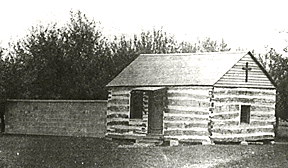 |
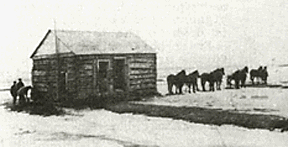 |
It had been used as a pig pen on the south farm, but was renovated to serve as a chapel until a new one was built. It became a playhouse for young children, and finally had to be torn down. |
| THE DENOYER FARM had a common boundary with the Crane Farm. The two also had in common millionaire owners who had others, either hired or renters, to do the actual farming. Philip Denoyer was a partner in the Denoyer Geppert map company of Chicago. He shared with his wife, Xenia, an interest in Girl Scouting. Virginia Haben was a neighbor whose daughter, Barbara, was in the Scout troop. Hope McGlothlin is dismayed on revisiting her old Girl Scout Camp. |
 |
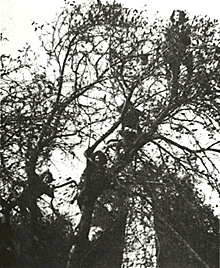 |
DENOYER LOG CABIN was the local campsite for Wheeling Girl Scouts for many years. It had tables, chairs, and a piano on the ground floor and a loft where the campers slept.
TREE CLIMBING wasn't in the Girl Scout handbook, but these girls filled a tree next to the Denoyer cabin and Lucille Schneider was there with her camera. |
| TINY OUTHOUSE had a shelf along one wall with three basins hung above it, and a faucet to draw water. It was near "Timbuktu," the original two-hole privy. Together they made up the sanitary facilities of the Denoyer Girl Scout camp. |
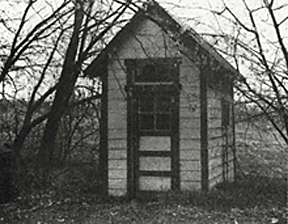 |
 |
EARLY POST CARD view of Milwaukee Avenue south of Dundee Road. Two buggies stand with tops tilted back, at a hitching rail in front of Schminke and Bollenbach stores on the west side. Laura Neiber and Lucile Schneider are on the sidewalk. |
| GENERAL STORES filled the basic needs of Wheeling's early settlers. John A. Schminke bought this building from Jacob Hunsinger in 1878. In 1918 Edward J. Welflin took it over. |
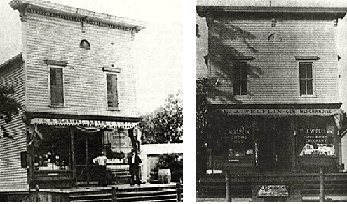 |
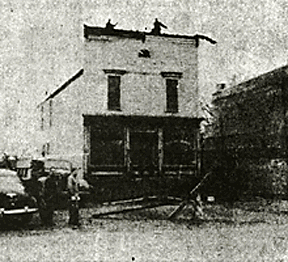 |
MASONIC TEMPLE building was raised by members of the Vitruvius Lodge. Cloice Wieder and Ray Lesch, members are at work on the roof while Robert Utpadel, Robert Benson and Edward Welflin watch from below. One of the founders was Joseph Filkins, Wheeling innkeeper. Vetruvius No. 81 was a "Moon Lodge" with meeting dates on the Saturday on or preceding the full moon -- so members could walk or drive home by moonlight. Photo is from the Wheeling Independent for April 9, 1954. A new Masonic Temple was built on the same site. |
LOOKS AND USES changed with the years. A frontier style false front characterized the Bollenbach store of the turn of the century, and six steps led up to the first floor. In 1918 Edward Welflin took over and the roof became Greek Revival with eaves turned inward. The front was extended, and entry was only one step up from the sidewalk. From a general store it had progressed to a variety store and in its last years it was known as Welflin's Sports Store. |
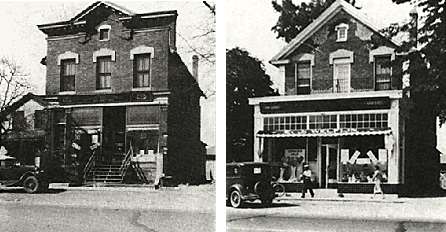 |
 |
STRYKER'S MEAT MARKET and home were side by side on the west side of Milwaukee Avenue south of Dundee Road. Ben Stryker cut ice from the river in the winter, and used it to keep meat fresh as he delivered it to farms for miles around. |
| FASSBENDER'S HARDWARE STORE stood on the southeast corner of Milwaukee Avenue and Dundee Road. It was built in 1845. The low building at left of the store was added much later and at different times housed Crawford's ice cream parlor, the Wheeling State Bank and the Royal Blue Store. Both were torn down in 1977 to make way for Riverside Plaza. |
 |
 |
THE PIEPERS made a smooth transition from horse and buggy days to the automobile age. August Pieper opened his blacksmith shop on Milwaukee Avenue in 1908. His sons worked with him and converted it into a garage (right) as times changed. |
| MOBIL OIL service station. One of Wheeling's first full-service gasoline and oil stations |
 |
 |
WHEELING MARKET was opened in 1906, moved into this new brick building at 115 S. Milwaukee Avenue in 1916. There were stock pens at the rear, an icehouse and a smokehouse. |
 |
WHEELING FARM STORE on the south side of Dundee Road just east of the river was built by Charles F. Balling. He sold vegetables, cider, dressed poultry and eggs to people from the Wheeling area and the North Shore suburbs. The property eventually was taken over by the Forest Preserve District. |
| HORSE-DRAWN station wagon from Frank Forke's livery stable made scheduled trips from Wheeling to the railway depot at Shermerville (now Northbrook). It served as a school bus for local children attending Maine Township High School, and of course, the wagon could be hired for outings. |
 |
 |
WHEELING HOSPITAL was opened by Dr. Edward Larson in 1927. While it was built to serve the community, it provided emergency facilities where Dr. Larson could patch up automobilists who survived the many accidents that occurred, especially on summer weekends, along heavily-traveled Milwaukee Avenue. The hospital began in the doctor's house, which was enlarged until finally he built a new house so the entire building could be used for treating his patients. The closest hospital, otherwise, was at Highland Park and some Wheeling people used Chicago hospitals when the situation was not one of emergency. |
|


























